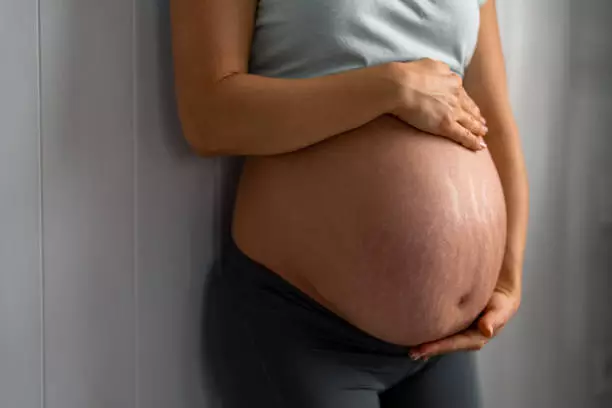What is a stretch mark during pregnancy?
A stretch mark in pregnancy is a scar that forms when the skin stretches or shrinks rapidly. These sudden changes cause collagen and elastin, two proteins essential for maintaining skin elasticity, to break. When they break, the skin heals poorly, leaving fine lines representing a subcutaneous rupture.
Main causes of stretch marks
Several factors can lead to the appearance of stretch marks:
- Pregnancy: This is one of the most common causes. During the second and third trimesters, a pregnant woman’s abdomen expands rapidly to accommodate the growing baby.
- Rapid weight gain: The rapid accumulation of fat in specific areas such as the hips, thighs and stomach can lead to stretch marks.
- Hormonal changes: Hormonal fluctuations reduce the skin’s spreadability, increasing the risk of stretch marks forming.
Areas where stretch marks frequently appear
Stretch marks can appear on various parts of the body, including:
- The stomach: Due to rapid expansion during pregnancy.
- Breasts: These can expand rapidly, especially if you are breast-feeding.
- Hips and thighs: These areas often store more fat.
- Buttocks: Another area prone to rapid fat accumulation.
Appearance and colour of a stretch mark during pregnancy
Stretch marks go through different phases. Initially, they appear in different shades depending on the skin tone:
Colour of stretch marks
Red, pink or purple striae : When they start to form, they often take on a reddish, pink or even purplish appearance caused by the initial inflammation and rupture of the blood vessels under the skin.
White or silver striae: Over time, stretch marks fade and turn white or silver. This phase indicates complete healing but leaves a permanent mark.
Preventing stretch marks during pregnancy
Although it is difficult to prevent stretch marks completely, a few measures can help:
Regular moisturising
It’s crucial to keep the skin well hydrated by applying specific creams or oils every day, such as :
- Sweet almond oil
- Cocoa butter
- Lotions containing vitamin E
This can improve skin elasticity and reduce the risk of striae.
Weight management
Controlling your weight gradually rather than drastically during pregnancy helps to limit sudden stretching of the skin.
Eating a balanced diet
Eating foods rich in vitamins C, E, zinc and silicon, which are essential for collagen production, can boost skin resilience.
Possible treatments to reduce stretch marks
If stretch marks persist despite preventive measures, several treatments can be considered to reduce them:
Creams and ointments
A number of topical treatment options are available, including :
- Products containing retinol
- Creams containing hyaluronic acid
- Ointments containing centella asiatica
It is always advisable to consult a dermatologist before applying any product.
Laser therapies
Fractional laser or microdermabrasion therapies can help stimulate collagen production and smooth the layers of skin affected by stretch marks.
Micro-needling
This treatment involves using a dermaroller equipped with tiny needles to create micro-perforations in the skin. This stimulates cell regeneration and increases collagen synthesis.
Emotional transformation of stretch marks
For many women, accepting their stretch marks becomes part of the emotional transformation that accompanies motherhood. Each stripe can be seen as a personal testimony to their unique journey towards motherhood. What’s more, remembering that these marks in no way affect overall health can help to keep a positive outlook.


